Descriptions of rabies go back thousands of years as it has classically been one of the most feared infections of all time. It is caused by a rhabdovirus that, in most cases, the disease is transmitted through a bite wound. So, you may find yourself asking, why does my indoor cat or dog that only goes outside to potty need a rabies vaccine? And the answer is wildlife CAN and WILL come inside. The most common wildlife species to spread rabies in Missouri are the skunk, bat, raccoon, fox, and coyote. It should be noted that wildlife (bats and raccoons especially) are able to gain access to indoor areas and potentially infect pets and people. Did you know there was recently a bat positive with rabies in St. Louis county?
It is because of rabies that St. Louis has pet licensing requirements in order to ensure that the community’s dogs and cats are vaccinated. When wildlife encounters humans or domestic animals, rabies becomes a public health problem. Despite vaccination being readily available, every year the U.S. reports the deaths of hundreds of dogs and cats from rabies, not to mention several human deaths. Rabies remains an important and nearly untreatable illness even now in the 21st century.
While it may take a long time for the virus to incubate, once even mild symptoms begin, death can occur within 10 days. Luckily, rabies prevention is accomplished with vaccination and limiting exposure to wildlife. The standard killed-virus vaccines are available for both cats and dogs. After the initial dose, (which is good for one year) subsequent doses are generally good for three years in Missouri. Call Hillside Animal Hospital today to ensure your family and pets are protected against rabies.
Meagan, RVT
Hillside Animal Hospital

